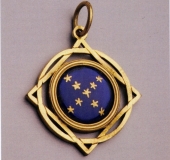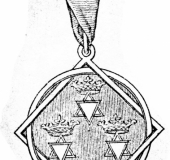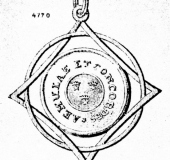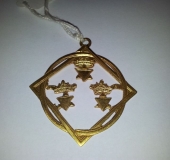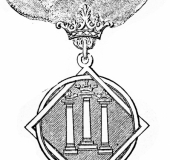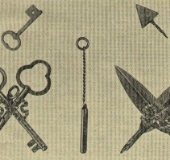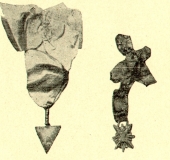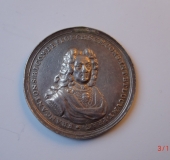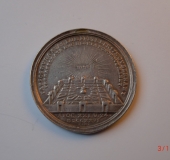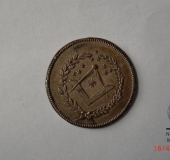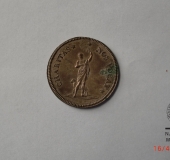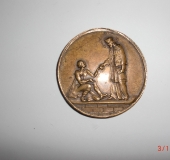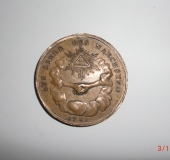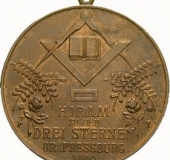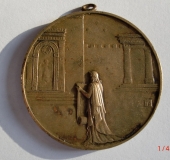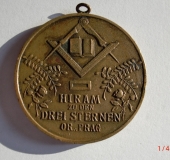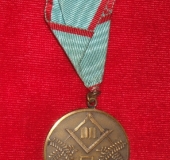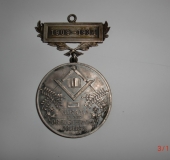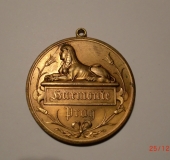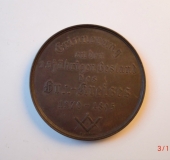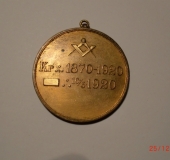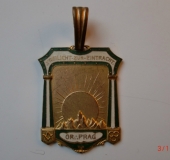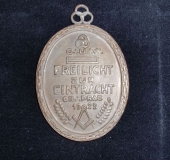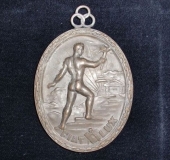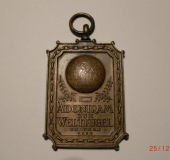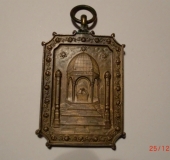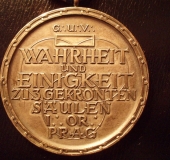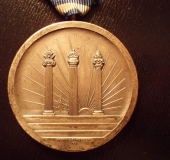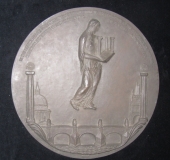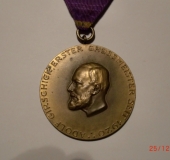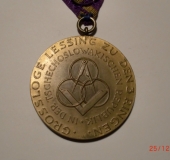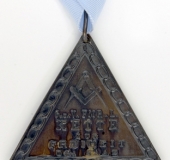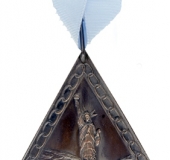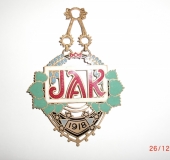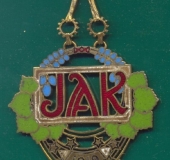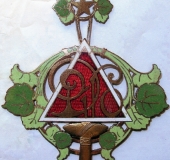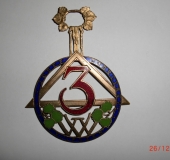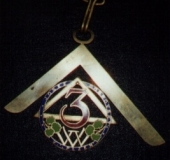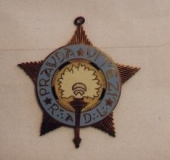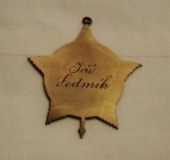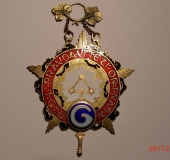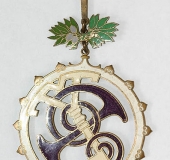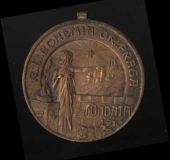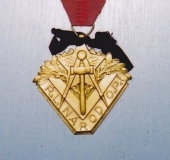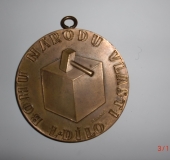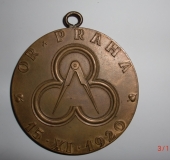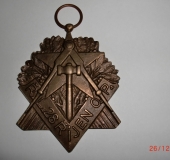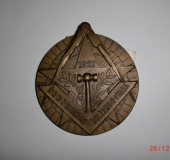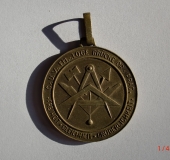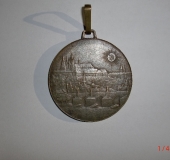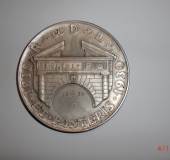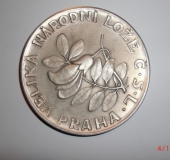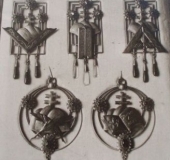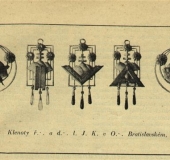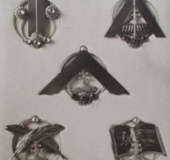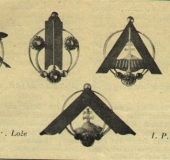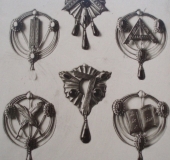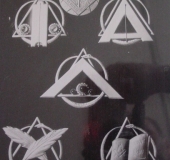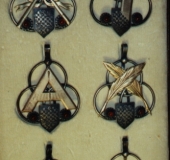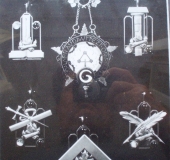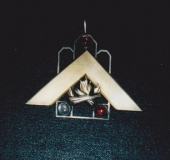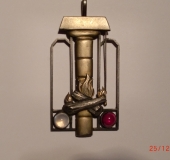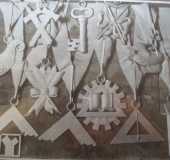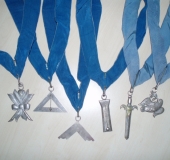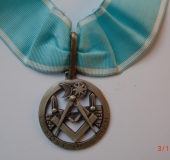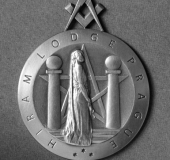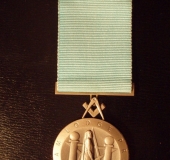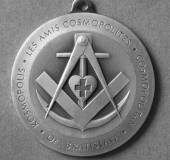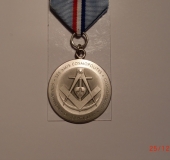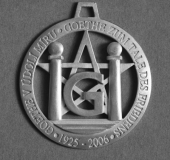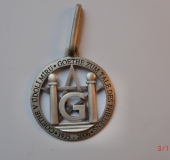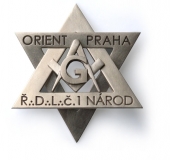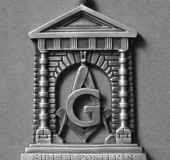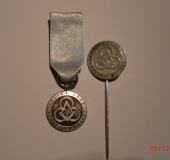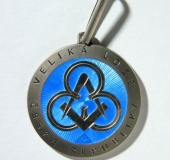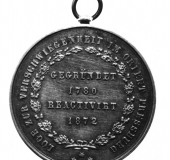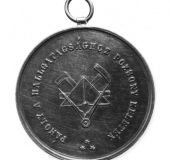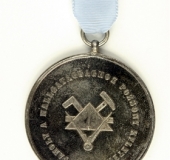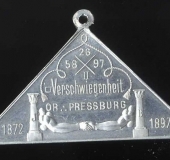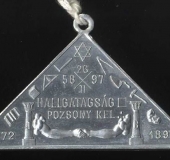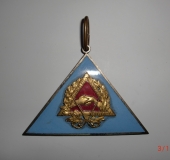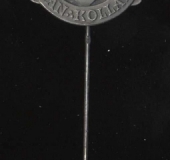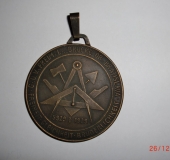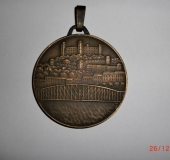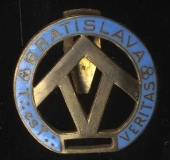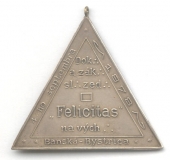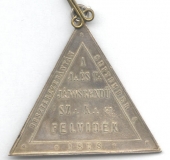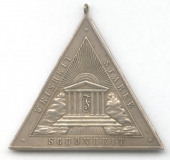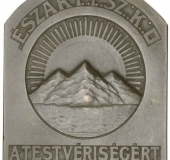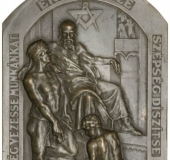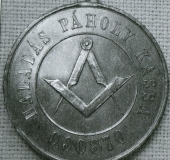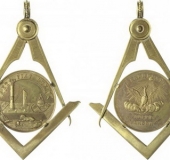Masonic jewels and medals.
By James F.
Since earliest days, Freemasons have been wearing lodge jewels. The first ones were to distinguish the lodge officers according their functions: The Worshipful Master would wear a square, a secretary two pens and so on. This practice spread from England to the rest of the world and great uniformity has been achieve here. In addition, to show membership of a particular lodge, lodge jewels were introduced. In the British Isles, however, this practice has been limited to only founding members of a lodge. In Continental Europe, a strong tradition of lodge jewels developed, whereby every member would receive at his initiation the jewel of his lodge. A big variety of materials, design and style emerged, reflecting the culture of each place.
One has to make a distinction between jewels and medals. The former are worn on a ribbon and are more like orders, whereas the latter are more like coins and used for commemorating a special event and kept as a souvenir, but not worn . In Central Europe, however, lodges had medals produced to be attached to a ribbon and this became than lodge jewels.
Prague and Bohemia have a long tradition of medal and jewel making, including masonic once. Many beautiful jewels have been produced, some of them by famous artist. The galleries hereunder will show jewels and medals in several groupings.
Prague jewels and medals of the 18th century.
Freemasonry came to Prague in 1741 with the French and Saxon armies but was short-lived. It re-emerged in 1764 and flourished for nearly 30 years to be suppressed in 1794. About 9 lodges were working in Prague, Klatovy, Brno and Opava. Unfortunately, not many jewels were made and even less survived. Only illustrations are known of the jewels of the lodges Zu den drei gekronten Sternen and Zu den drei gekronten Saulen. Of the other Prague lodges like Wahrheit und Einigkeit and Union we do not know if they had jewels. And the same goes for the loges Sincerite in Klatovy, Zur aufgehende Sonne and Zu den wahren vereinigten Freunden in Brno and Pythagoras in Opava.
Luckily, the beautiful jewel of the lodge Zu den neun Sternen survived and is today in the possession of the Umělecko průmyslové museum in Prague. It is interesting, that all three main lodges in Prague have chosen for a same design as this one.
The 19th century was also in Bohemia a time of Romanticism, national revival and nationalism. The past was glorified and if necessary, facts and events were invented. So did the history writer Josef Svátek create a legend that Count Sporck was the first Freemason in Prague and as proof of this he claimed a medal of Sporck dated 1726 was struck to commemorate the establishment of the first lodge in Prague. Max Donnebauer, the collector with a large numismatic collection in Prague in the middle of the 19th century had a silver token described by Dr J. Merzdorf and Eduard Fiala as being Masonic, struck around 1773 by the lodge Zu den neun Sternen to commemorate the opening of the Prague Masonic Orphanage of St John Baptist. On one side it shows St John the Baptist pointing to the sun and around the words: CHARITAS NOS VOCAT. On the other side are square, compasses and nine stars. This was, alas, wrong. It appears to be a token of the lodge La Parfaite Union et Saint Jean du Désert réunis in Valenciennes, France.
Another token described by Eduard Fiala in his Beschreibung der Sammlung böhmischen Münzen und Medaillen des Max Donnebauer, Prague 1888, was a small bronze medal, according to him issued by the lodge Wahrheit und Einigkeit in 1781 to commemorate the charitable help of the Prague brethren for the victims of a great flood in 1784 (!). One side shows St John Nepomuk giving bread to a poor. The other side shows clasped hands under a triangle with Gods name and with clouds around and the words: AUS LIEBE DES NACHSTEN. This masonic interpretations of both tokens has been taken over by Abafi (Ludwig Aigner) in his famous study Geschischte der Freimaurerei in Oesterreich-Ungarn, Budapest,1892. However, also this allocation was wrong, caused probably that one side of this token shows some correlation with the seal of the lodge Wahrheit und Einigkeit. The fact is, that this medals was the badge of members of a charitable organization helping the poor. Its name was Verein aus Liebe des Nachsten (Society Love they Neighbor) and was set-up by Johan Nepomuk Count Buquoy on his estates in South Bohemia. The first initiative was taken in 1779 followed by the official opening in 1781.
Click on picture to enlarge and read explanatory text. All shown items are in private possession unless mentioned otherwise.Jewels and Medals of lodges under the Grossloge Lessing zu den drei Ringen in Prague.
The Grossloge Lessing zu den drei Ringen was founded in 1920 in Prague by German speaking lodges on the territory of the newly created Czechoslovak Republic. Up to the end of WWI, when Prague and Bohemia formed a part of the Austo-Hungarian Empire, Freemasonry was not allowed in the Czech lands. However, among the German speaking inhabitants of Prague and the border areas (Sudenten) where about 600 Masons, who were members of lodges “cross the border” in Silesia, Saxony, Bavaria or in Pressburg (Poszony, Bratislava) which was then part of Hungary, and where, paradoxically, Masonry was allowed. These brethren went for open lodge meetings to the neighboring countries, but at home in Prague, Karlsbad-Karlovy Vary, Saaz-Žatec, Reichenberg-Liberec and Gablonz-Jablonec they created masonic circles. At war end and after the collapse of the Empire, the Constitution of the new and democratic Czechoslovak Republic guaranteed freedom of establishing lodges. All masonic circles converted into lodges, followed by the establishing of the Grand Lodge Lessing. New lodges were subsequently established in Prague, Bohemia and Moravia. Lodges which operated in Slovakia and Ruthenia and speaking German or Hungarian joined Grand Lodge Lessing. It was a successful masonic body, growing to 31 lodges and a membership of 1700 across the Republic. Sadly, in 1938, at the eve of Nazi-occupation the Grand Lodge and all its lodges closed down, never to be reopened again.
All lodges had a jewel or medal designed. This was presented to a newly initiated members and always worn at open lodge meetings. Mostly it would hang around the neck on a ribbon and only exceptionally it could be a breast jewel, more like in England. The material was mostly bronze, sometimes enameled, practically never silver. Gilded bronze was also popular. A variety of designs and subjects were applied. Regularly we see masonic symbols and an often repeated motive are three interlaced rings taken from the name of the Grand Lodge. Local and historical motives have been also popular. The design of the medals was in many cases by lodge members, in several cases the name is mentioned on the medal: Leopold Pick, Paul Albert Kopetzky and Viktor Oppenheim. The following gallery shows a selection of “Lessing” medals, mostly from private collections.
Jewels of the Národní Veliká Lože Československá (National Grand Lodge of Czechoslovakia).
The Czech speaking Freemasons of the newly created Republic Czechoslovakia established in Prague lodges Jan Amos Komenský (1918), Národ (1919), 28.Říjen (1919), Dílo (1919), Most (1925), Bernard Bolzano (1927), Pravda Vítězí (1928), Sibi et Posteris (1930) Baruch Spinoza (1933), Dílna Lidskosti (1935) and Pravda a Svornost u vychazejíciho Slunce (1937). The National Grand Lodge of Czechoslovakia was established in 1923 by the Grand Lodge of Yugoslavia. Before the beginning of the Second World War, there were 10 Czech speaking lodges in Prague and only 5 German speaking. Outside Prague, however, there were much less Czech speaking loges (4) than German speaking (14). The National Grand Lodge of Czechoslovakia had in Plzeň lodge Josef Dobrovský (1922), in Brno lodge Cestou Světla (1926) in Olomouc lodge Lafayette na třech rovinách (1933) and in Ostrava Lux in Tenebris (1934). The Opus Magnum of Czech masons was to create a humanitarian and democratic republic. France, Britain and the United States were the countries were the Czech masons were looking for inspiration. The early links were with irregular masonic bodies like the Scottish Rite in Rome, Grand Orient de France etc. It was Grand Master Karel Weigner who consolidated the Czech Grand lodge by following more British masonic practice and achieved in 1930 recognition of the National Grand Lodge of Czechoslovakia by the United Grand Lodge of England. Interestingly, at the same time London recognized also Grand Lodge Lessing at the three Rings in Czechoslovakia and the Grand Lodge of Vienna.
One of the most dedicated Czech masons was the famous Art Nouveau artist Alfons Mucha. He designed the first masonic jewels for several Czech lodges (Komenský, Dílo, Dobrovský, Pravda Vítězí…) in his unique and beautiful Art Nouveau style. His first design for lodge J A Komenský became later famous and much publicized and it appeared in many book. However, the most bizarre appearance was in the poster of the Grand Anti-Masonic Exhibition in Belgrade in 1941and Another designer created officers jewels for several lodges in a very unique Czech Art Deco style. However, from the mid-twenties a modern style in design of jewels and medals was emerging. Renown artists as Josef Frendlovský, Julius Pelikán and Jaroslav Horejc created lodge jewels of high quality. With the increasing orientation on Britain in the thirties, the Grand Officers jewels follow the classical English design, where the Czech element is visible only in the three intersecting circles.
A unique collection of Czech Masonic Art Deco officers jewels.
After the creation of the Czechoslovak Republic in 1918, Czech Masons focused in the 1920ties on building a Czechoslovak “National” Freemasonry. For that purpose a special design was made for the officers jewels. The design seems to be by one author only, unfortunately we do not know his name, apart that it ends on -k . In an article in the Czech Masonic magazine Svobodný Zednář in 1926 the designer explains his ideas and motivations. The symbol for the officers (Worshipful Master, Senior and Junior Wardens, Chaplain and Secretary) were embellished with the sun, ouroboros, a flame as symbol for the Prevailing Truth, Moravian eagle for the lodge in Brno and Slovak national symbols for lodges in Bratislava and Košice. Circles and rectangular wires and Serbian filigree work was used, as a tribute to the Grand Lodge of Yugoslavia, which chartered the Czechoslovak Grand Lodge in 1923. Finally, semi-precious stones like carnelian and moon stone were added. The jewels were made by a jeweler in Prague, allegedly at low costs. All in all we have here a small and unique collection of masonic jewels made in a typical Czech Art Deco style, popular in the period 1920-1928. After 1930 followed an orientation on English masonic practice and a new set for all lodge officers were designed, closely following English standards.
Jewels of the Grand Lodge of the Czech Republic. (After 1990)
After re-awakening of Masonry in Prague after 1990 a whole range of beautiful lodge jewels have been designed by the medal and jewel designer Petr Vogel. These were for private lodges as well as for the Grand Lodge. They are all one sided and from sterling silver, to be worn either around the neck on a ribbon or as a breast jewel. On the one hand Vogel created a variety of intriguing designs, reflecting the name, tradition or spirit of each lodge and on the other hand there is a clear unity in style and execution. One can conclude, that the artistic quality of Czech lodge jewels have been always very exceptional and with the work of Petr Vogel reached a new height not only in the Czech lands but on an European and World level.
Jewels of lodges in Slovakia.
In the 18th century there were lodges active in Bratislava, Banská Bystrica, Košice and Prešov. Not much is know about them. In the 19th century, when in 1867 a new constitutional arrangement created the Austro-Hungarian Empire, the Hungarian part of the monarchy adopted a more liberal constitution, allowing the formation of lodges and Grand Lodges. This was not possible in the Austrian part of the monarchy, to which Prague, Bohemia and Moravia belonged. As Slovakia was for centuries part of the Hungarian Kingdom (Upper Hungary) it could now also freely establish masonic lodges. In 1870 the Grand Lodge of Hungary was established, followed next year by the creation of the Grand Orient of Hungary. Both Grand Lodges established fraternal relations with the United Grand Lodge of England. In 1886 both merged into the Symbolic Grand Lodge of Hungary. Bratislava (Pressburg, Poszony), the main city of Slovakia became in the period 1870-1918 an important Masonic center. With ca 60 000 inhabitants it was a small town, but with up to 18 lodges it achieved a high masonic prominence. How to explain this? Two “local” lodges were established there: Germans speaking Verschwiegenheit in 1872 and Hungarian speaking Testveriség in 1902. These took care for the brethren who really lived in Bratislava. In addition, there were up to 16 lodges established by Freemasons from Vienna. This reflects the paradox, that Freemasonry was legal in Hungary and illegal in Austria and Vienna. The Vienna brethren did circumvent this problem by establishing lodges in Bratislava, which is only 60 km from Vienna and and easily accessible by tram and train. In Vienna they operated legally charitable associations. Outside Bratislava were also lodges established in Košice, Prešov, Banská Bystrica, Kežmarok, Lučenec, Gemert and Plešivec. All lodges had their warrants from the Symbolic Grand Lodge of Hungary. Freemasonry reached its zenith in Hungary briefly before WWI, when there were ca 7 000 brethren. In Bratislava alone, the number of Masons reached to ca 1 200.
With the end of WWI and the disintegration of the Austrian-Hungarian Empire, new states emerged: Republic Czechoslovakia, Republic Austria and the Kingdom Hungary. Now the tables turned: The democratic constitutions in Czechoslovakia and Austria allowed Freemasonry unrestricted to develop whereas in Hungary it became now prohibited. As a consequence, all Viennese lodges moved from Bratislava to Vienna. Lodges in Slovakia, which had its warrant from the Grand lodge in Budapest and spoke German or Hungarian, decided to seek protection of the in 1920 formed Grand Lodge Lessing in Prague. Moreover, the in 1923 formed National Grand Lodge of Czechoslovakia chartered Slovak speaking lodges in Bratislava and Košice and later in other cities. In October 1938 all Masonic activities in Slovakia ceased to operate.

